In 2021, Jonathan Fawkner shared insights into Framestore‘s visual effects for No Time To Die. Today, he returns to discuss his latest work on Wicked.
How did you and Framestore get involved on this show?
This film has been long in gestation. Framestore had worked with Universal and Mark Platt to pitch and greenlight Wicked as far back as 2020.
How did it feel to enter into the Wicked universe?
On our first meeting with Jon Chu he was immediately inclusive. He shared his casting videos of Cynthia Erivo and Ariana Grande: he shared his love of the genre and his passion for this story. He was also clear about how he would be relying on us; he put his trust in us and it was inspiring. From the get go we were fully invested. I knew there was common ground with the work I had done before and felt it was absolutely the right fit.
What are the sequences made by Framestore?
Framestore’s sequences are interwoven throughout the film; we extended Nathan Crowley’s sets for Munchkinland, including hectares of CG tulips, floating bubbles, and crowd expansion. Shiz University extensions and wider environment, and the buildings of Emerald City as seen from the ground. Doctor Dillamond and the other animal faculty were all made at Framestore including a caged lion cub and the Ozdust band. Framestore Pre-Production Services (FPS) were heavily involved with the film, and supplied previs and postvis on all of our sequences as well as the Defying Gravity number, which went to ILM for final VFX.
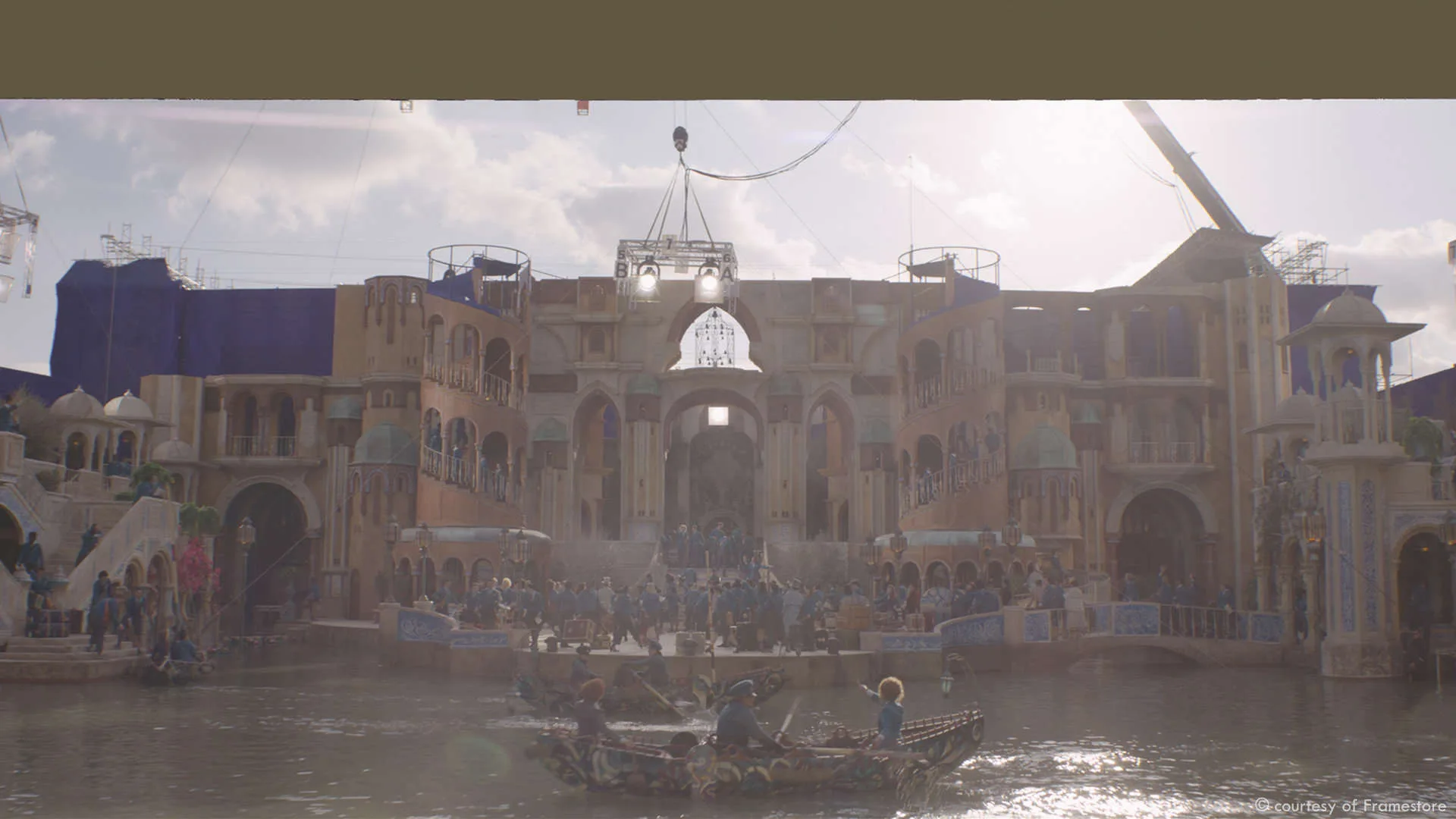
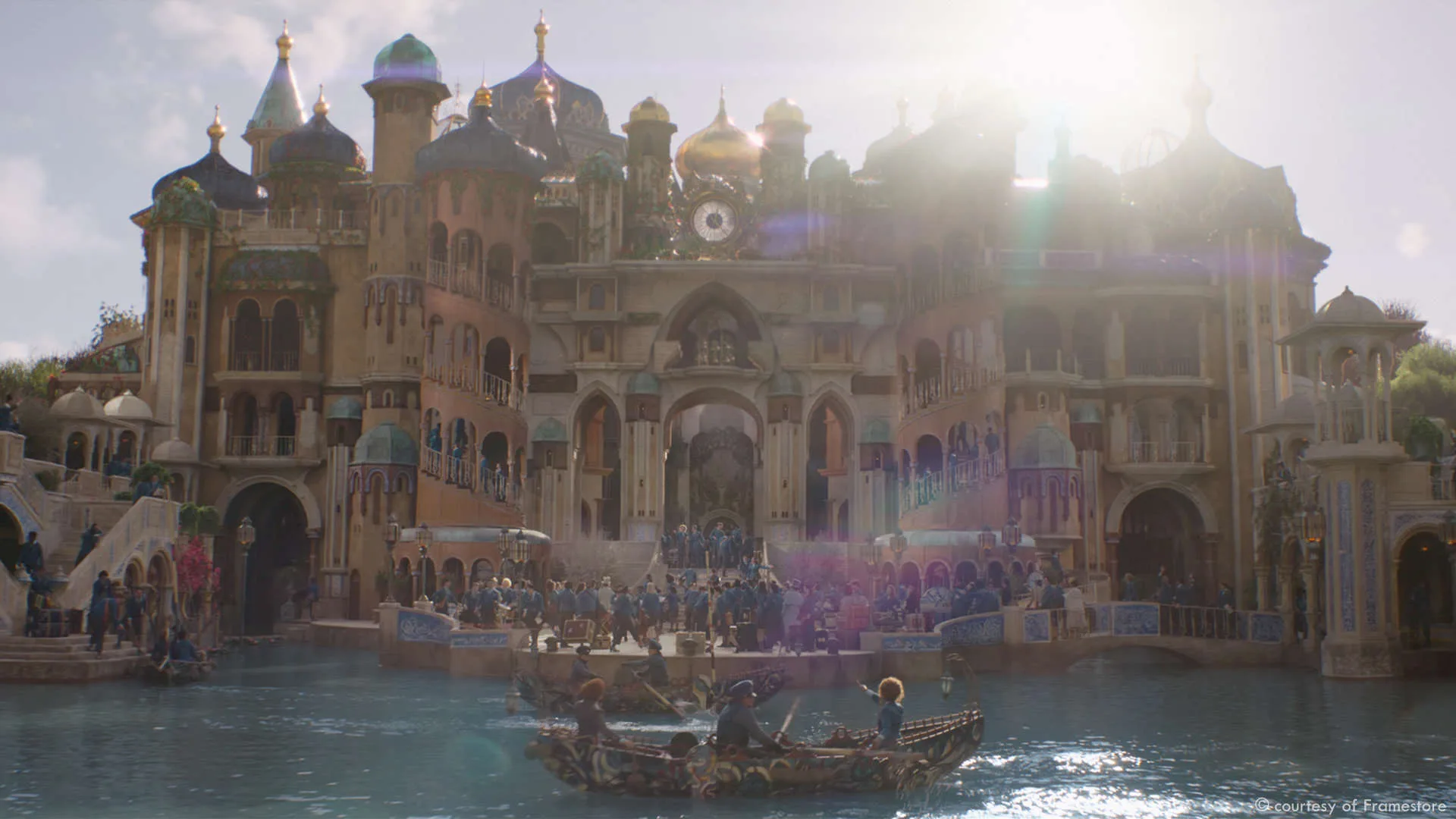
What is your role on set and how do you work with other departments?
We started shooting both parts in December 2022. Pablo Helman, Production VFX Supervisor, and I worked side by side largely splitting the work across the sequences that ILM and Framestore would handle. I spent a lot of time with 2nd Unit, who were providing a lot of VFX plates. I often found that I was the one member of the 2nd unit crew that was present for the main unit shoot, providing valuable eyes and ears. It also meant that I could add my own priorities to the shot list, knowing what I would need. We finished shooting in January 2024 after a small hiatus for the actors’ strikes.
Can you tell us about the creative process behind designing the magical landscapes of Wicked? How did you approach capturing the unique aesthetic of Oz?
Nathan Crowley had already established that Munchkinland would be the heart of the textile dye industry of Oz (the colour comes from tulips). He planted 9 million tulips which provided backdrop for closeup and medium shots of the cast. For the wides we needed to blend the flat Norfolk landscape into the rolling hills of Munchkinland. This meant our Montreal team had to not only build what must have been billions of our own digital tulips but also match the cadence of the subtle wind interaction, to effect a seamless blend from the Norfolk location to the Hertfordshire backlot. Then it was a case of designing a pleasing pattern for the fields and landscape cues to reinforce the epic scale.
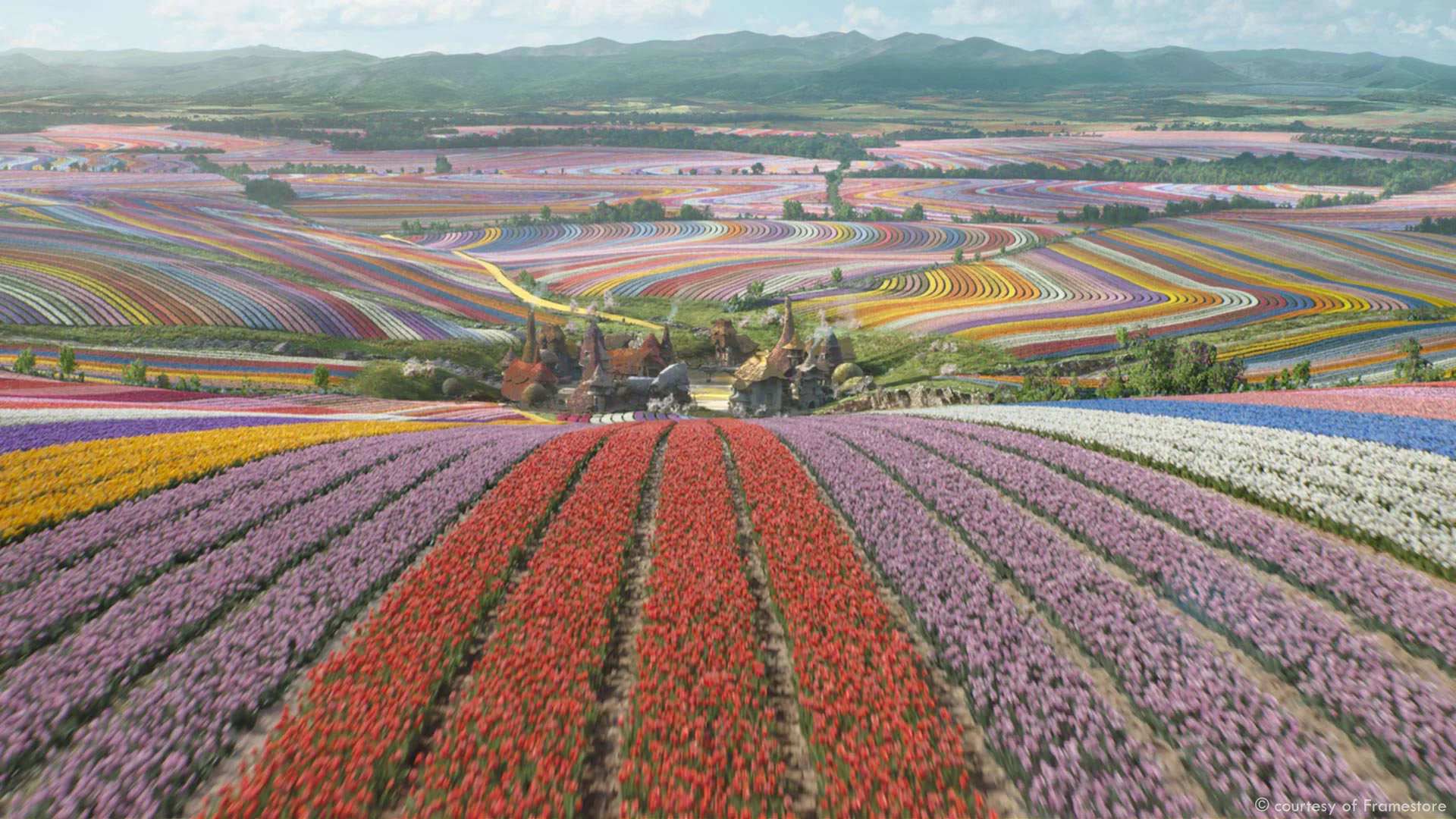
What were the biggest challenges in creating the environments for Wicked? Were there any specific scenes that required particularly complex solutions?
The sets Nathan Crowley built were enormous and richly detailed, and so the extensions had to follow suit. Our design team came on in post-production so channelling the style and craftsmanship in camera is always a challenge: we need to honour the aesthetic while also ‘motivating’ the camera after the fact. It’s retrospective.
Big as the sets were, they still left a lot to top up. The sort of light you get on an exterior set that stops at 50’ is very different to one that is surrounded by tall buildings, so extensions are not simply a case of copy and paste. Shadows and ambient light are completely different, camera flares are no longer motivated etc. Keeping it photoreal requires some sleight of hand on each shot. Throughout the film we manipulated the plate to add direct light, extend shadows, design architectural glass to reflect light into the lens to replicate set lights placed by Alice Brooks (Director of Photography). What we inherited from production design was a beautiful architect’s sketch. What we needed was to act like an architectural designer: to assign the actualities. All the details, from window frames, to gutters to sculptures had to have a little Ozian touches and genuine appeal. To keep it cost effective the designs needed to work across multiple shots that were not necessarily framed with that in mind. As ever with set design in post, we don’t have the luxury of letting the camera react to the set. We have to design the set to work with ALL the cameras… after the fact.
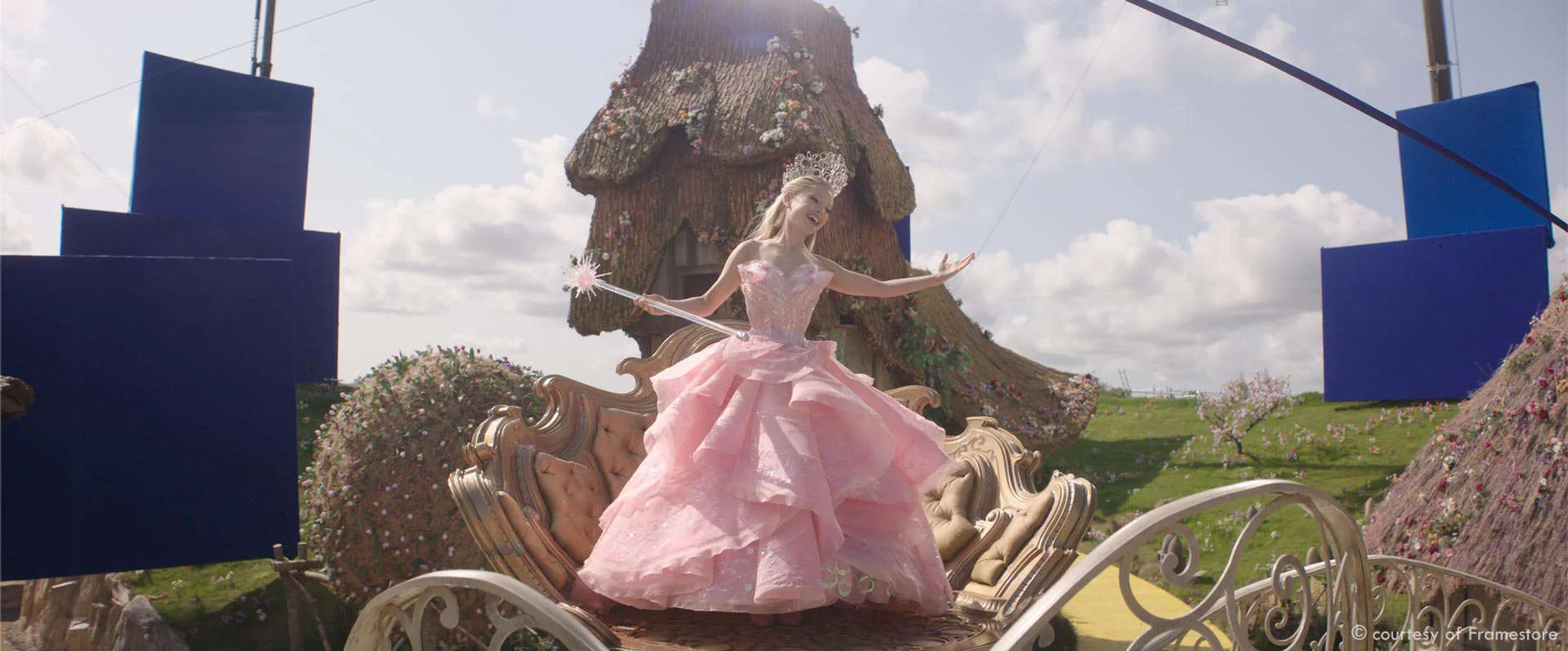
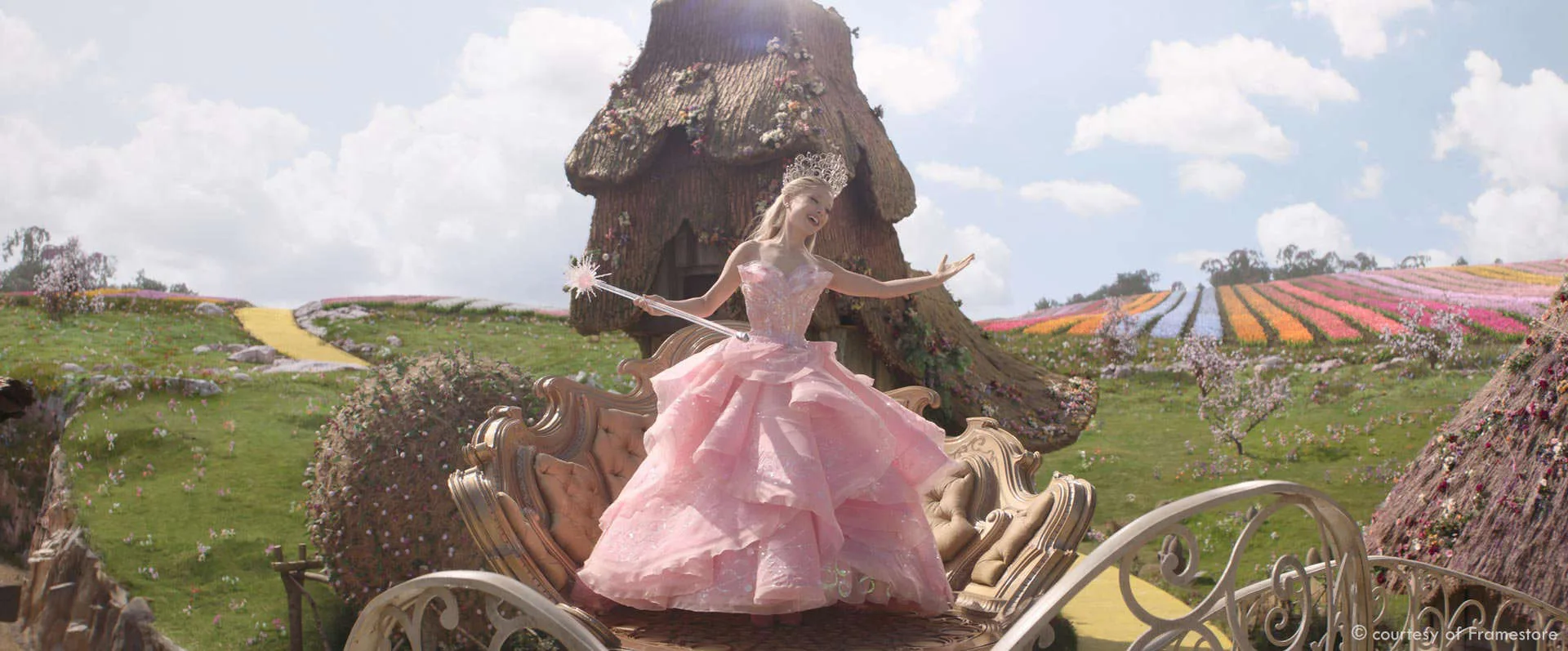
How did Framestore collaborate with the production team to ensure the environments complemented the storytelling and characters?
The sets for certain events were physically separate at the studio but connected in Oz and across two movies too, so we were keen to offer environment solutions that kept everything connected and consistent while remaining compositionally satisfying. Jon Chu is very good at appreciating the implications of any particular design choice and we made sure to walk him through many options before embarking on long digital builds. We always start with architectural solutions and he’s excellent at distilling the essence of the design issues but also reminding us of the story points that they serve.
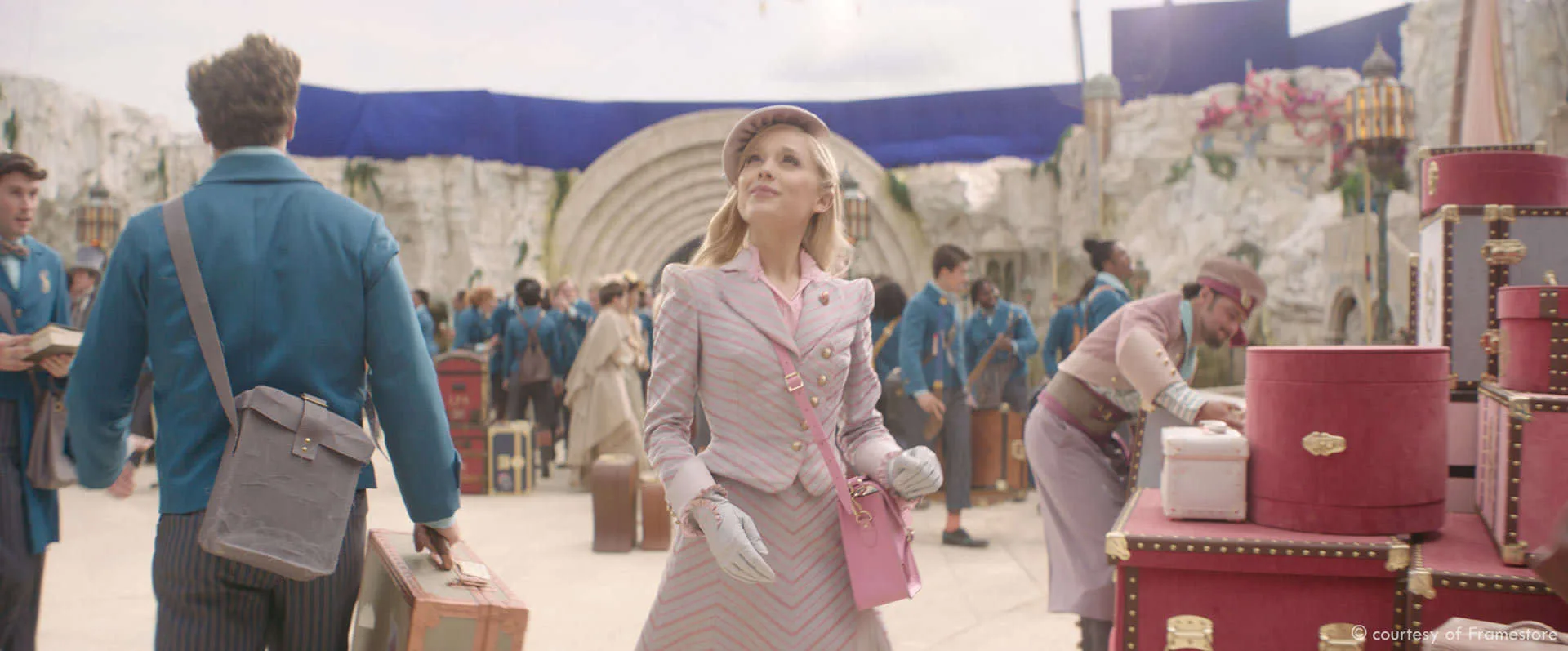
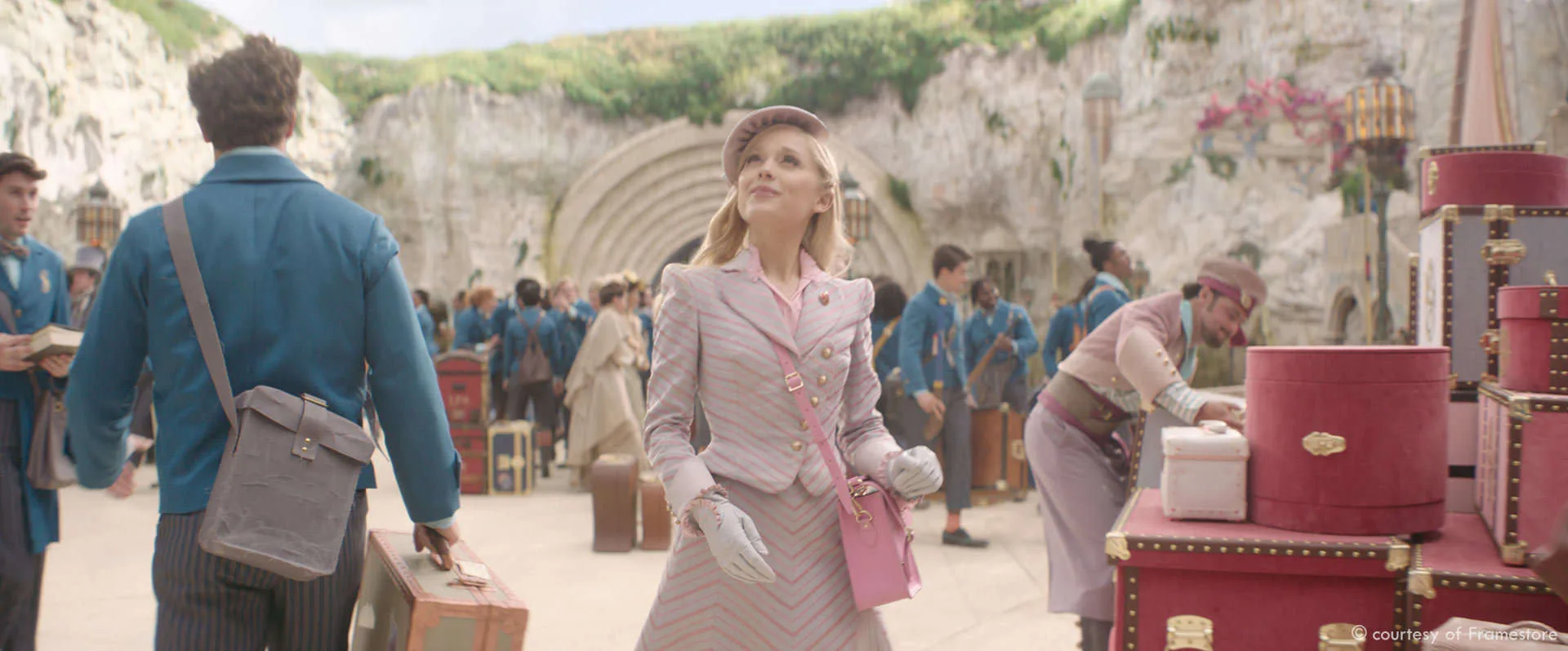
Were there any practical sets blended with your CG environments, and how did you achieve seamless integration?
This is the case on nearly every set. Our sets were huge and in most cases work continued on them even after the unit started there. We were careful to match materials from the set but we also had shots where we were able to achieve a richer finish than the painted fibreglass, so our work replaced areas of the set that were perhaps not finished, or were never expected to feature, but did.
Did you use any new technologies or techniques to enhance the realism and magic of the environments in Wicked?
Wicked is fantastical and while we always strive to replicate reality of a physical scene, no one on this production ever pretended that Oz was a real place – that encourages the film makers to allow themselves license to lean into design even at the expense of realism. That said, our work succeeds when it looks as hyper real as the physical production design or lighting and brings that same sense of delight that Jon is always striving for.
For the digital crowd I used a technique that I had not previously encountered. Partnering with Dimension Studios, we photographed the background cast volumetrically. This enabled richly detailed cloth and facial performances without the need for complex rigs or crowd sims. Relighting was made easy by splitting geometry and texture. What was harder was separating different materials.
On Wicked we utilised machine learning techniques to help with the separation, and this meant thousands of frames of dancing crowds did not pose quite so much of a problem as it might have done in years past. The limitation with this approach ended up being logistical. With a small window where cast, wardrobe, make-up and catering were available, there was a limit on data storage and bandwidth available on Dimension’s mobile studio setup. This meant we could only store one minute of performance per agent. We had at least one minute of action we wanted from our crowd so I had to compose a concise menu of actions to be performed without breaks and without error. To make sure it was even possible, I put myself in costume and became one of the crowd’s munchkins.
Doctor Dillamond is such a unique character. How did you approach his design and animation to balance his animalistic traits with his human-like qualities?
Our Art Department had produced the concepts for Doctor Dillamond, so in VFX we began to cast about for a real goat to form the base for our character. Bizarrely, I happen to have a goat sanctuary down the road from where I live, and they had a goat that fit the bill with the right size and shape. This meant we had a basis for believability which was always Jon’s starting point.
Dale Newton, our Animation Supervisor, and the animation team constantly adapted what they wanted out of facial muscles and groom from the asset team to capture a particular expression. Out of this Dillamond slowly appeared. We also worked with the costume department to get samples of the different fabrics and designs of the human professors at Shiz, so that we could do our best to match Dillamond’s attire to that of his colleagues.
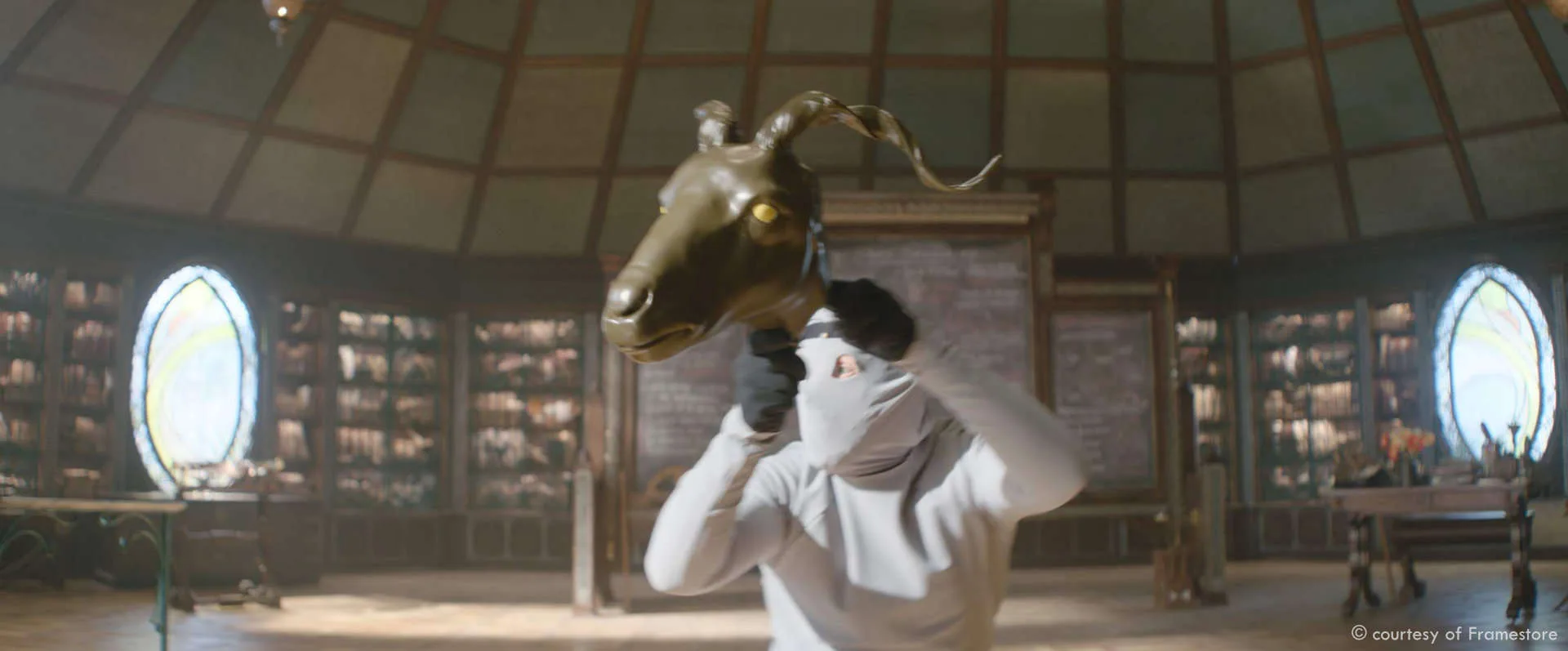

What specific challenges did you face in bringing Doctor Dillamond to life, both visually and in terms of performance?
Doctor Dillamond does not have much screen time, but in many ways he embodies the emotional MacGuffin for Wicked. Elphaba’s empathy with animals has to be quickly established and her sympathy with the plight of this animal in particular really has to land in order to achieve that.
Characters based on animals with monocular vision are often anthropomorphised for cinema – to bring their eyes and the emotional read closer to that of a human. I was very glad that Jon was not interested in this because it gave us an opportunity to deliver a performance on a creature that did not require too great a leap of faith from the audience. I mean, he talks and sings but he wasn’t especially designed visually for that.
When Peter Dinklage delivered his read, it gave us waypoints to hit in terms of expression but the animation team were also constantly proposing alternatives to Jon. You read a lot more subtlety in a human face than you do on a goat, so we couldn’t just lift from Peter directly. We had to draw on smaller physical traits of his character to further enhance the overall performance. His ears are lovely signifiers, his eyes can look particularly askance and his glasses are a useful prop to overtly gaze over. This is the stuff that was particularly useful in his reaction shots, when there is no vocal performance to match.
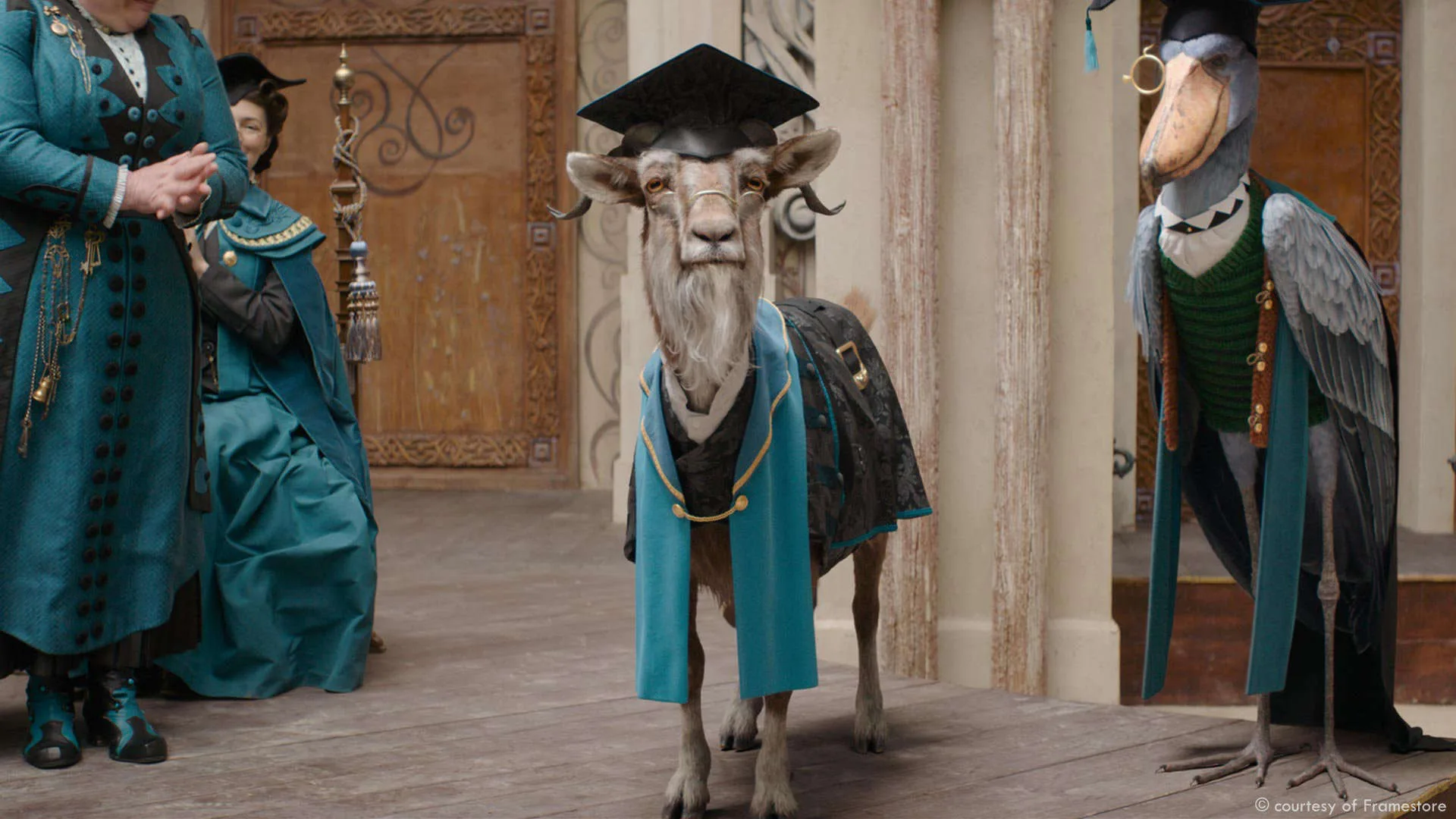
Can you elaborate on how Framestore worked with the actors and directors to ensure Doctor Dillamond’s movements and expressions aligned with the narrative?
Whenever we had Doctor Dillamond or any of his faculty in a scene, we had performers on set who would provide blocking with the actors. This enabled Jon to see his scene quite vividly and respond to the cast and the decisions they made, even if it was a tiny monkey on a stick. Of course, we tried to get clean passes with very minimal markers and relying on the muscle memory of the actors, but inevitably some of the best takes had the puppeteers still in the frame, which called for some quite heroic paint-out work.
When patience and time allowed, usually on 2nd unit, we would record the output of the camera during the puppet pass and in an act of impressive low tech efficiency, simply play it back on a phone mounted on the wheels to achieve the same sense of reaction on an empty plate.
Were there other creatures in Wicked that posed unique challenges for Framestore? Could you share some insights into their creation?
The most fun we had with a lot of the creatures was finding what aspect of them, to a greater or lesser extent, made them ‘Ozian’. It involved a huge amount of design work. Deviating from nature is always a delicate balance which by and large Jon was attuned to, so giving a giraffe a mullet or a snow leopard a Dali moustache was lots of fun. It’s not easy to know what should come first when you are casting about for animals for an animal band. Visual interest, or musical viability. Who knew chickens would play an Ozian piano, or a sugar glider the drums? And not just any chickens either. They had to be the most elaborate show chickens we could find! (They had some at the goat sanctuary…which was handy!).
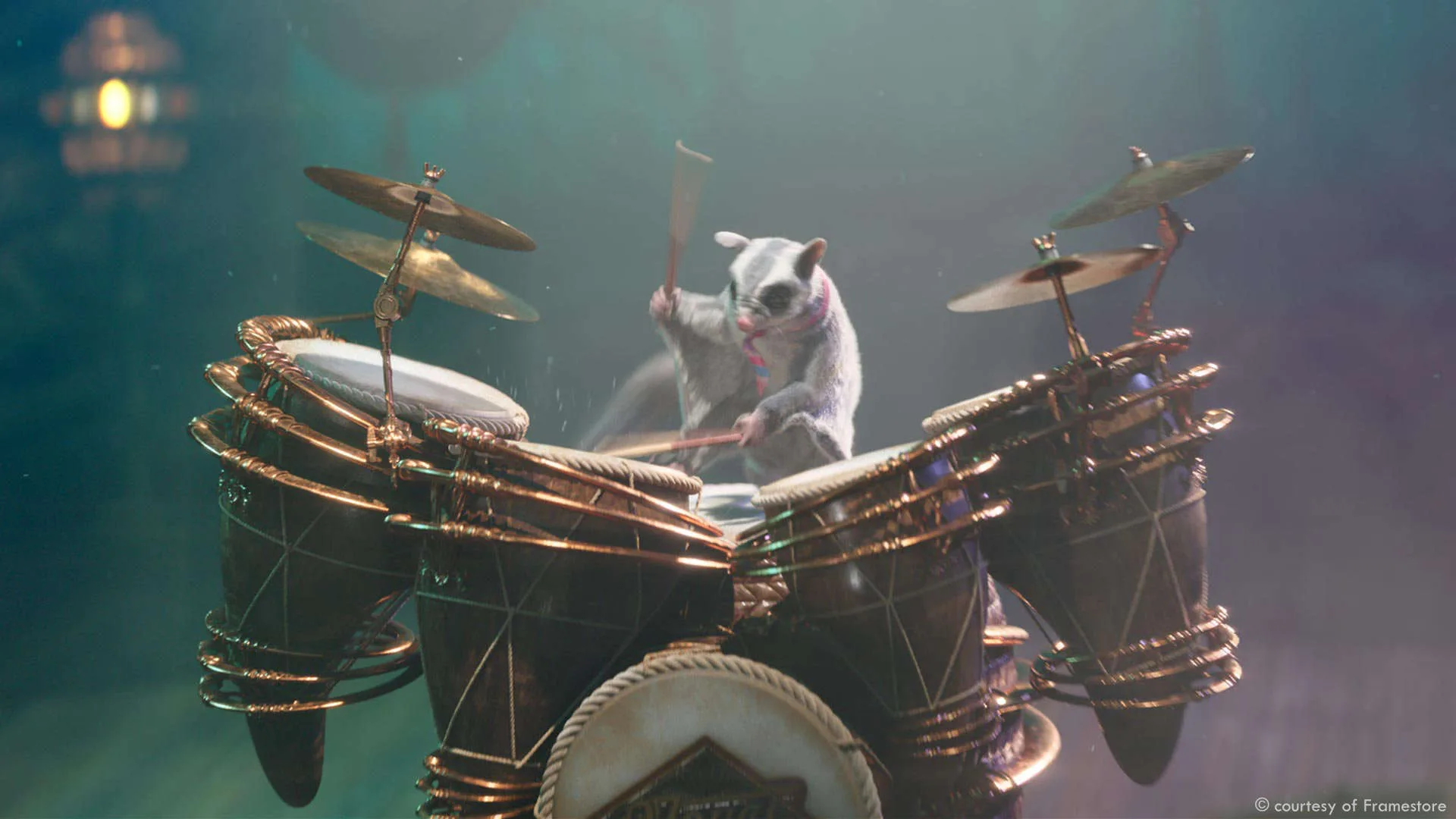
Were there any unexpected technical or creative challenges encountered during the production?
We don’t have many massive full CG shots. Some, but not many. Even most of our establishers feature an element of main unit photography. With a singing cast and often huge background chorus it really did not leave a lot of time or headspace for the film-makers to pause to consider visual effects. We had to fight for attention next to the other crafts who were all operating at capacity.
My back garden became an unofficial backlot and now that my iPhone can shoot at 24fps underwater in log I was able to supplement the effects. We had a pyro shoot for fireworks, my daughter played Glinda’s hand cutting through the surface of the water and I played the Wizard projection emerging from a cloud of mist during the Wizomania show. It was low tech solutions that were made possible by high tech advances.
Looking back on the project, what aspects of the visual effects are you most proud of?
I got pretty involved in this film. Thanks to so many generous people, from Pablo and his team, to Jon, the 2nd unit team, our amazing data wranglers lead by Chris Lynch, the Clear Angle team as well as my own wonderful Framestore and FPS teams, I am so honoured to have my fingerprints everywhere. There’s no one aspect that stands out.
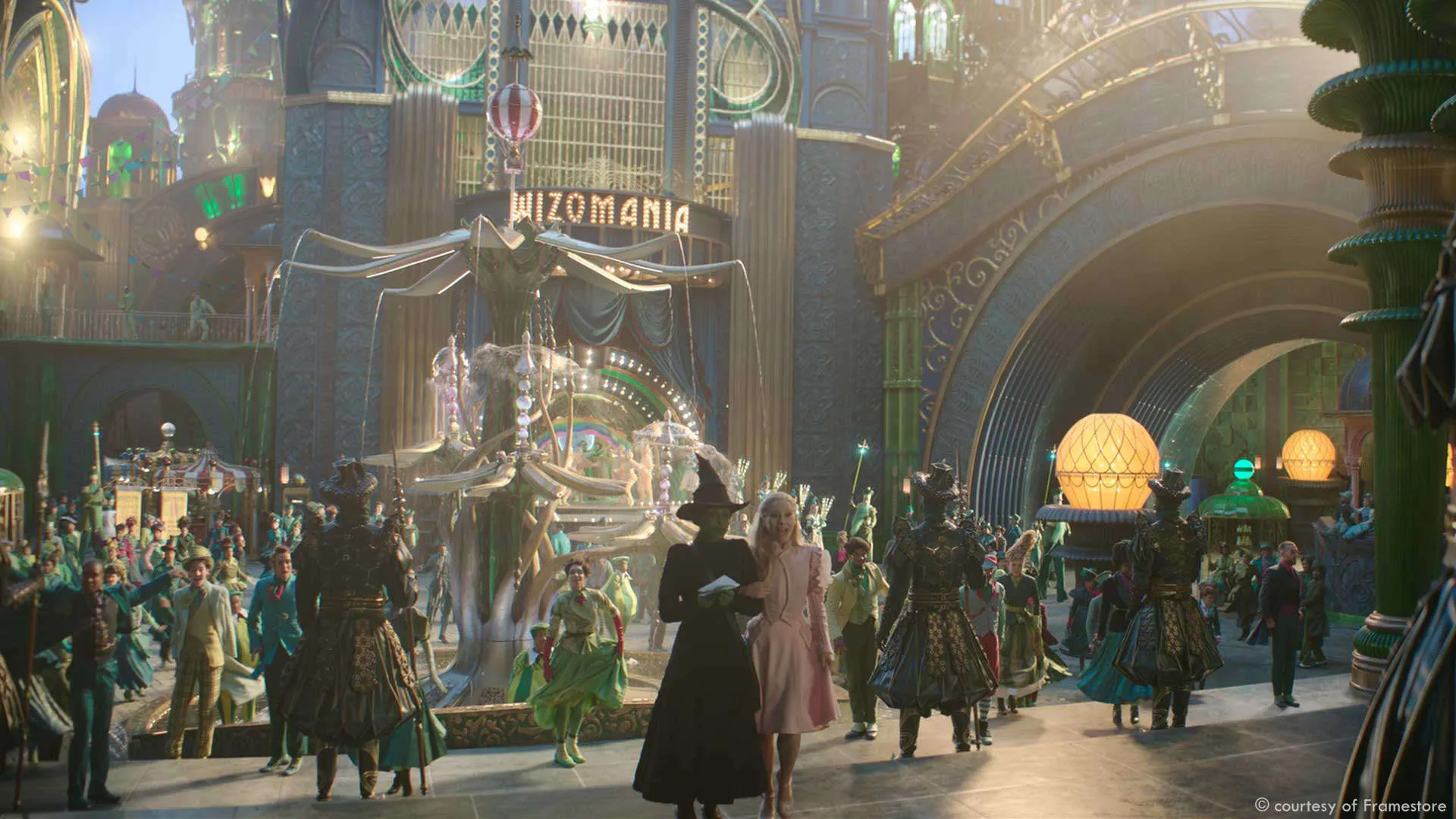
How long have you worked on this show?
It’s about 2.5 years to date.
What’s the VFX shots count?
Framestore delivered 870 shots for the film.
What is your next project?
We’ll be going back to Oz for Part Two!
A big thanks for your time.
// TRAILERS
WANT TO KNOW MORE?
Framestore: Dedicated page about Wicked on Framestore website.
© Vincent Frei – The Art of VFX – 2025




